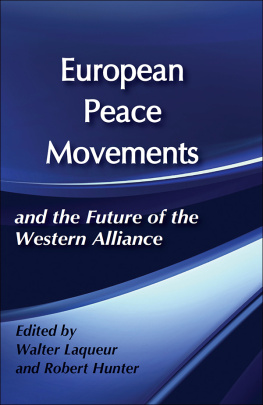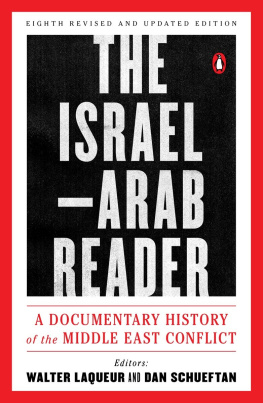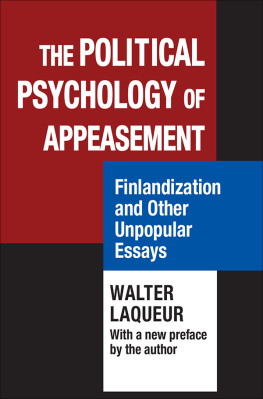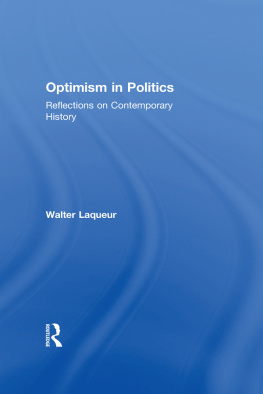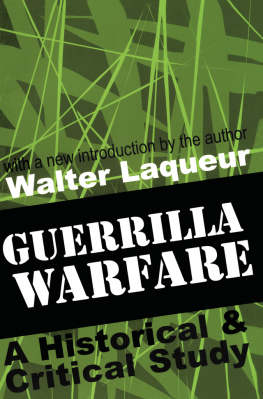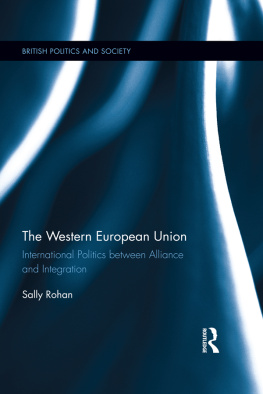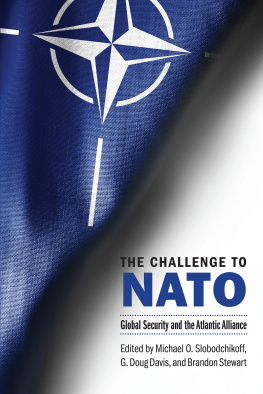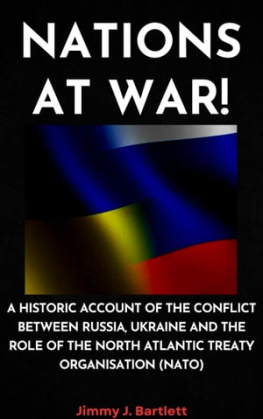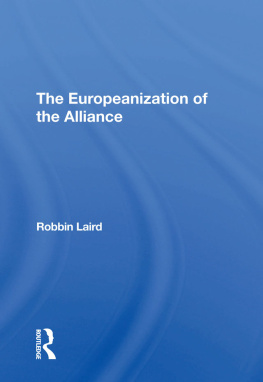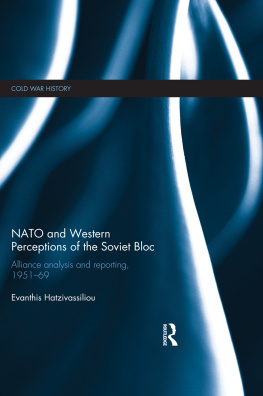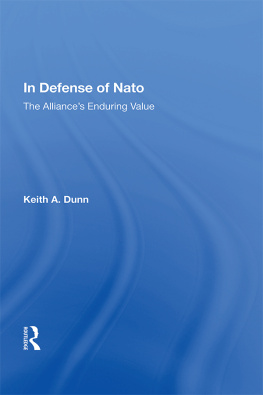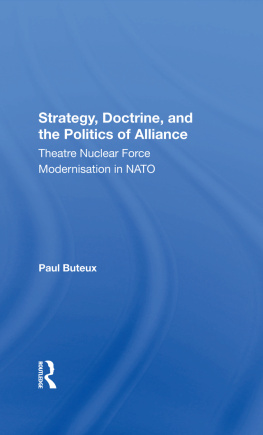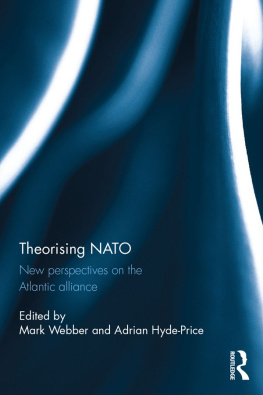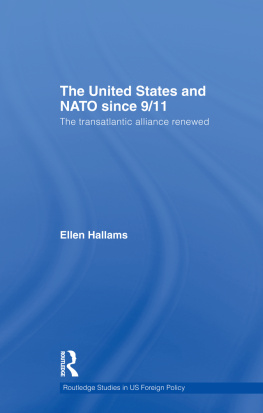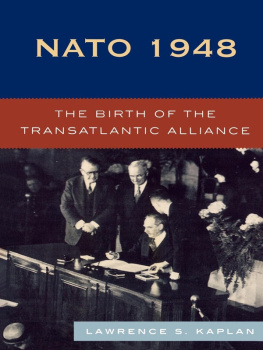First published 1985 by Transaction Publishers
Published 2017 by Routledge
2 Park Square, Milton Park, Abingdon, Oxon 0X14 4RN
711 Third Avenue, New York, NY 10017, USA
Routledge is an imprint of the Taylor & Francis Group, an in forma business
Copyright 1985 by the Center for Strategic & InternationalStudies, Georgetown University, Washington, D.C. 20006.
All rights reserved. No part of this book may be reprinted or reproduced or utilised in any form or by any electronic, mechanical, or other means, now known or hereafter invented, including photocopying and recording, or in any information storage or retrieval system, without permission in writing from the publishers.
Notice:
Product or corporate names may be trademarks or registered trademarks, and are used only for identification and explanation without intent to infringe.
Library of Congress Catalog Number: 84-24423
Library of Congress Cataloging in Publication Data
Main entry under title:
European peace movements and the future of the Western Alliance.
1. PeaceSocieties, etc. 2. Antinuclear movementEuropean. 3. North Atlantic Treaty Organization. 4. EuropeForeign relations United States. 5. United StatesForeign relationsEurope. I. Laqueur, Walter, 1921 II. Hunter, Robert Edwards, 1940.
JX1952.E97 1985 327.172 84-24423
ISBN 0-88738-035-2
ISBN 13: 978-0-88738-035-8 (hbk)
ABM Antiballistic Missile
AFSC American Friends Service Committee
ARD German Television
ARP Anti-Revolutionary Party
ASF In the Name of Atonement/Peace Services
ATOM Astronomical Telescope Orientation Mount (NASA)
BDKJ Federation of German Catholic Youth
BRPF Bertrand Russell Peace Foundation
CALC Clergy and Laity Concerned
CDA Christian Democratic Appeal (Dutch)
CDA-VVD Liberal Party
CDFP Campaign for a Democratic Foreign Policy
CDS Christian Democratic Party (Dutch)
CDU Christian Democratic Union
CERES Left-wing Socialist Party (French)
CFDT French Labor Union
CHU Christian Historical Union (Dutch)
CND Campaign for Nuclear Disarmament Peace Movement
CNFMP Coalition for a New Foreign and Military Policy
CNFP Ad Hoc Coalition for New Foreign Policy
CODENE Committee for the Denuclearization of Europe
CPN Communist PartyNetherlands
CPSU Communist PartySoviet Union
CPUSA Communist PartyUnited States of America
CSCE Conference on Security and Cooperation i n Europe
CSF Coalition to Stop Funding the War
CSIS Center for Strategic and International Studies
CSSR Czechoslovak Socialist Republic
CSU Christian Socialist Union
D66 Democraties 66
DAC Direct Action Committee (British)
DDR Deutsche Democratische Republik
DGB Trade union umbrella organization (German)
DKP German Communist Party
EC European Community
EEC European Economic Community
EKD Evangelical Churches of Germany, Council of
END European Nuclear Disarmament
EVP Evangelical Peoples Party
FAR Force dAction Rapide
FAS Federation of American Scientists
FBS Forward Based Systems
FDP Free Democratic Party
FOR Fellowship for Reconciliation
FRG Federal Republic of Germany
GDR German Democratic Republic
GLCMs Guided Missile Countermeasures
GNP Gross National Product
HADES Missile
ICBM Intercontinental Ballistic Missile
ICDP International Confederation for Disarmament and Peace
IKV Dutch Interchurch Peace Council
INF Intermediate Nuclear Forces
KGB Soviet Secret Police
KOR Committee for Defense of the Workers
KVP Catholic Peoples Party (Dutch)
LCNP Lawyers Committee on Nuclear Policy
LOVO Dutch peace organization
LRTNF Long-Range Theater Nuclear Forces
MBFR Mutual and Balanced Force Reductions
MFS Mobilization for Survival
MX Missile Experimental
NATO North Atlantic Treaty Organization
NCASF National Council American-Soviet Friendship
NCC National Council of Churches
NTA No to Nuclear Weapons
NWFC Nuclear Weapons Freeze Campaign, Inc.
OCV Consultation Center for Peace (Belgium)
PCF French Communist Party
PS Socialist Party
PSP Party of Political Radicals
PSU Unified Socialist Party
PVdA Labor Party (Dutch)
RPR Gaullists
SACEUR Supreme Allied CommanderEurope
SALT Strategic Arms Limitation Talks
SAM Strategic Airborne Missile
SANA Scientists Against Nuclear Arms
SANE National Committee for a Sane Nuclear Policy (SANE alone used as an organization name)
SDP German Social Democratic Party
SLBM Submarine Launched Ballistic Missile
SPD Social Democratic Party
SSBN Missile launching nuclear Submarines
START Strategic Arms Reduction Talks
TACT Tories Against Cruise and Trident
TNF Tactical Nuclear Forces
TUC Technology Utilization Center
UCS Union of Concerned Scientists
UDF Union Defense Force (British)
USPC United States Peace Council
USSR Union of Soviet Socialist Republics
VAKA Flemish Action Committee Against Atomic Weapons
VELKD United Evangelical-Lutheran Churches of Germany
WD Liberals (Dutch)
WDC World Disarmament Campaign
WILPF Womens International League for Peace and Freedom
WPC World Peace Council
WRL War Resisters League
WSP Women Strike for Peace
ZdDK Centralm Committee of German Catholics

